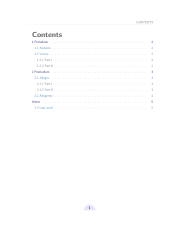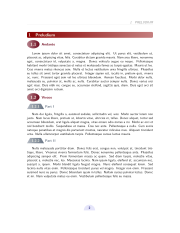LaTeX/主题
LaTeX 新手经常会因为该系统缺乏视觉自定义功能而感到失望。实际上,这是有意为之:LaTeX 的理念是专注于格式化,而让作者专注于内容。
在本节中,我们将展示通过一些努力可以实现的目标。
简介
[edit | edit source]接下来,我们将编写主题,一个只改变文档外观的包,这样我们的文档就可以使用或不使用主题。
请注意,虽然它可能看起来很美观,但这绝对不是排版的典范。你不应该在严肃的出版物中使用这种主题。这更多的是一个技术示例,展示 LaTeX 的功能。
-
自定义主题(目录)
-
自定义主题
-
自定义主题(红色)
包配置
[edit | edit source]这里没有什么好说的。这直接应用了创建包一章的内容。
我们加载所需的包。
- needspace 用于防止在分节命令后立即出现分页符。
- tikz 用于绘制花哨的素材。
我们定义了一个颜色选项,你可以根据需要使用任意数量的选项。使用特定名称定义颜色使其非常灵活。我们还使用了一个选项来切换花哨的反射效果,这可能有点过分!
\NeedsTeXFormat{LaTeX2e}
\ProvidesPackage{theme-fancy}[2013/01/13 v1.0 fancy theme]
%%%%%%%%%%%%%%%%%%%%%%%%%%%%%%%%%%%%%%%%%%%%%%%%%%%%%%%%%%%%%%%%%%%%%%%%%%%%%%%%
%% Packages
\RequirePackage{geometry}
\RequirePackage{needspace}
\RequirePackage[svgnames]{xcolor}
\RequirePackage{hyperref}
\hypersetup{colorlinks=true}
\RequirePackage{fancyhdr}
\RequirePackage{tikz}
\usetikzlibrary{
calc,
decorations.pathmorphing,
fadings,
shadows,
shapes.geometric,
shapes.misc,
}
%%%%%%%%%%%%%%%%%%%%%%%%%%%%%%%%%%%%%%%%%%%%%%%%%%%%%%%%%%%%%%%%%%%%%%%%%%%%%%%%
%% Options
%% Toggle reflection.
\newif\if@mirrors\@mirrorsfalse
\DeclareOption{mirrors}{
\@mirrorstrue
}
%% Colors.
\newif\if@red\@redfalse
\DeclareOption{red}{
\@redtrue
}
\ExecuteOptions{}
\ProcessOptions\relax
%%%%%%%%%%%%%%%%%%%%%%%%%%%%%%%%%%%%%%%%%%%%%%%%%%%%%%%%%%%%%%%%%%%%%%%%%%%%%%%%
%% Configuration
\renewcommand{\familydefault}{\sfdefault}
\setlength{\parskip}{0.5\baselineskip}
%% Colors
\colorlet{toctitle}{DarkGray!50!black}
\colorlet{titlebg}{MidnightBlue}
\colorlet{titlefg}{LightBlue}
\colorlet{titletxt}{MidnightBlue}
\colorlet{sectionfg}{MidnightBlue}
\colorlet{subsectionfg}{SteelBlue}
\colorlet{subsubsectionfg}{LightSteelBlue!60!black}
\if@red
\colorlet{toctitle}{DarkGray!50!black}
\colorlet{titlebg}{DarkRed}
\colorlet{titlefg}{FireBrick!50}
\colorlet{titletxt}{DarkRed}
\colorlet{sectionfg}{DarkRed}
\colorlet{subsectionfg}{Crimson!50!black}
\colorlet{subsubsectionfg}{LightSteelBlue!60!black}
\fi
|
页眉和页脚
[edit | edit source]我们使用 TikZ 绘制一个填充的半圆。
fancyhdr 用于设置页眉和页脚。我们注意使用 fancy 样式,并通过 \fancyhf{} 从头开始擦除之前的页眉和页脚。
%%%%%%%%%%%%%%%%%%%%%%%%%%%%%%%%%%%%%%%%%%%%%%%%%%%%%%%%%%%%%%%%%%%%%%%%%%%%%%%%
%% Header and Footer
\tikzstyle{foliostyle}=[fill=Lavender, text=MidnightBlue, inner sep=5pt, semicircle]
\pagestyle{fancy}
\fancyhf{}
\fancyfoot[C]{
\vskip 3pt
\begin{tikzpicture}
\node[foliostyle]
{\bfseries\thepage};
\end{tikzpicture}
}
\renewcommand{\headrulewidth}{0.8pt}
\addtolength{\headheight}{\baselineskip}
\renewcommand{\headrule}{\color{LightGray}\hrule}
\fancyhead[LE]{ \textcolor{gray}{\slshape \rightmark} }
\fancyhead[RO]{ \textcolor{gray}{\slshape \leftmark} }
|
目录
[edit | edit source]我们重新定义了 \tableofcontents 所使用的命令。
%%%%%%%%%%%%%%%%%%%%%%%%%%%%%%%%%%%%%%%%%%%%%%%%%%%%%%%%%%%%%%%%%%%%%%%%%%%%%%%%
%% Table of contents
\newcommand{\sectiontoccolor}{sectionfg}
\newcommand{\subsectiontoccolor}{subsectionfg}
\newcommand{\subsubsectiontoccolor}{subsubsectionfg}
\renewcommand*\l@section{\color{\sectiontoccolor}\def\@linkcolor{\sectiontoccolor}\@dottedtocline{1}{1.5em}{2.3em}}
\renewcommand*\l@subsection{\color{\subsectiontoccolor}\def\@linkcolor{\subsectiontoccolor}\@dottedtocline{1}{2.3em}{3.1em}}
\renewcommand*\l@subsubsection{\color{\subsubsectiontoccolor}\def\@linkcolor{\subsubsectiontoccolor}\@dottedtocline{1}{3.1em}{3.9em}}
\def\contentsline#1#2#3#4{%
\ifx\\#4\\%
\csname l@#1\endcsname{#2}{#3}%
\else
\csname l@#1\endcsname{\hyper@linkstart{link}{#4}{#2}\hyper@linkend}{%
\hyper@linkstart{link}{#4}{#3}\hyper@linkend
}%
\fi
}
%% New title format -- 'section' is used by default.
\newcommand{\tocformat}[1]{{\Huge\bf#1}}
\renewcommand\tableofcontents{%
\tocformat{
\textcolor{toctitle}{\contentsname}
\@mkboth{\MakeUppercase\contentsname}{\MakeUppercase\contentsname}
}%
\@starttoc{toc}%
}
|
分节
[edit | edit source]这绝对是最复杂的部分。它并不难,因为 \section、\subsection 和 \subsubsection 的代码几乎相同。
我们使用 \needspace 来确保在分节命令后不会出现换行符。我们将命令包含在一个组中,在该组中设置字体大小,因为我们需要的是 \baselineskip,它取决于字体大小。
带星号的命令不会设置计数器(LaTeX 的默认行为)。你可以选择通过重置计数器来以不同的方式处理带星号的命令。
我们在打印部分之前使用 \noindent。我们确保使用 \par 命令结束打印部分,以确保后面的文本能够正确打印。
对于 \subsection,我们使用 mirrors 选项来相应地更改外观。
为了正确处理 PDF 书签,我们需要在定义的末尾添加以下几行。
\phantomsection
\addcontentsline{toc}{section}{\thesection~#1}
|
最后,仅对于 \section,我们希望它在页眉中打印,因此我们调用 \sectionmark 命令。在这里,我们改变了带星号命令的行为,使其与原始 LaTeX 版本不同,因为我们定义并使用了 \sectionmarkstar 命令。
%%%%%%%%%%%%%%%%%%%%%%%%%%%%%%%%%%%%%%%%%%%%%%%%%%%%%%%%%%%%%%%%%%%%%%%%%%%%%%%%
%% Section style
\renewcommand\section{
\@ifstar
\my@sectionstar
\my@section
}
%% Note: to justify, text width must be set to \textwidth - 2*(inner sep).
\tikzstyle{sectionstyle}=[
inner sep=5pt,
text width=\textwidth-10pt,
left color=sectionfg!100!white,
right color=sectionfg!50!white,
rounded corners,
text=Ivory,
rectangle
]
\newcommand\my@section[1]{
\stepcounter{section}
{\Large\needspace{\baselineskip}}
\noindent
\begin{tikzpicture}
\node[sectionstyle] {\bfseries\Large\thesection\quad#1};
\end{tikzpicture}
\par
\phantomsection
\addcontentsline{toc}{section}{\thesection~#1}
\sectionmark{#1}
}
\newcommand{\sectionmarkstar}[1]{\markboth{\MakeUppercase{#1}}{}}
\newcommand\my@sectionstar[1]{
{\Large\needspace{\baselineskip}}
\noindent
\begin{tikzpicture}
\node[sectionstyle] {\bfseries\Large#1};
\end{tikzpicture}
\par
\phantomsection
\addcontentsline{toc}{section}{#1}
\sectionmarkstar{#1}
}
%%%%%%%%%%%%%%%%%%%%%%%%%%%%%%%%%%%%%%%%%%%%%%%%%%%%%%%%%%%%%%%%%%%%%%%%%%%%%%%%
%% Subsection style
\renewcommand\subsection{
\@ifstar
\my@subsectionstar
\my@subsection
}
\tikzstyle{subsectionstyle}=[
left color=subsectionfg!50!white,
right color=subsectionfg!100!white,
text=Ivory,
ellipse,
inner sep=5pt
]
\newcommand\my@subsection[1]{
\stepcounter{subsection}
{\Large\needspace{\baselineskip}}
\noindent
\begin{tikzpicture}
\node[subsectionstyle,anchor=west] (number) at (0,0) {\bfseries\Large\thesubsection};
\if@mirrors
\node[above right,subsectionfg,anchor=south west] at ($(number.east)+(0.1,-0.1)$) {\large\bfseries#1};
\node[yscale=-1, scope fading=south, opacity=0.4, above, anchor=south west, subsectionfg] at ($(number.east)+(0.1,0.1)$) {\large\bfseries#1};
\else
\node[above right,subsectionfg,anchor=west] at ($(number.east)+(0.1,0)$) {\large\bfseries#1};
\fi
\end{tikzpicture}
\par
\phantomsection
\addcontentsline{toc}{subsection}{\thesubsection~#1}
}
\newcommand\my@subsectionstar[1]{
{\Large\needspace{\baselineskip}}
\noindent
\begin{tikzpicture}
\node[subsectionstyle,anchor=west] (number) at (0,0) {\bfseries\Large\phantom{1}};
%
\if@mirrors
\node[above right,subsectionfg,anchor=south west] at ($(number.east)+(0.1,-0.1)$) {\large\bfseries#1};
\node[yscale=-1, scope fading=south, opacity=0.4, above, anchor=south west, subsectionfg] at ($(number.east)+(0.1,0.1)$) {\large\bfseries#1};
\else
\node[above right,subsectionfg,anchor=west] at ($(number.east)+(0.1,0)$) {\large\bfseries#1};
\fi
\end{tikzpicture}
\par
\phantomsection
\addcontentsline{toc}{subsection}{#1}
}
%%%%%%%%%%%%%%%%%%%%%%%%%%%%%%%%%%%%%%%%%%%%%%%%%%%%%%%%%%%%%%%%%%%%%%%%%%%%%%%%
%% Subsubsection style
\renewcommand\subsubsection{
\@ifstar
\my@subsubsectionstar
\my@subsubsection
}
\tikzstyle{subsubsectionstyle}=[
left color=subsubsectionfg!50!white,
right color=subsubsectionfg!100!white,
text=Ivory,
shape=trapezium,
inner sep=5pt
]
\newcommand\my@subsubsection[1]{
\stepcounter{subsubsection}
\noindent
\begin{tikzpicture}
\node[subsubsectionstyle] (number) {\bfseries\large\thesubsubsection};
\node[subsubsectionfg, right of=number, anchor=west] {\large\bfseries#1};
\end{tikzpicture}
\par
\phantomsection
\addcontentsline{toc}{subsubsection}{\thesubsubsection~#1}
}
\newcommand\my@subsubsectionstar[1]{
\noindent
\begin{tikzpicture}
\node[subsubsectionstyle] (number) {\bfseries\large\vphantom{1}};
\node[subsubsectionfg, right of=number, anchor=west] {\large\bfseries#1};
\end{tikzpicture}
\par
\phantomsection
\addcontentsline{toc}{subsubsection}{#1}
}
\endinput
|
注释和参考文献
[edit | edit source]




